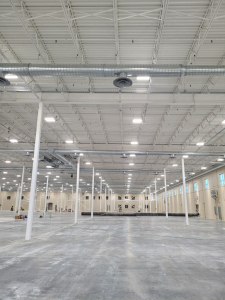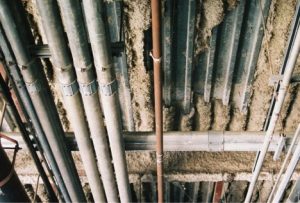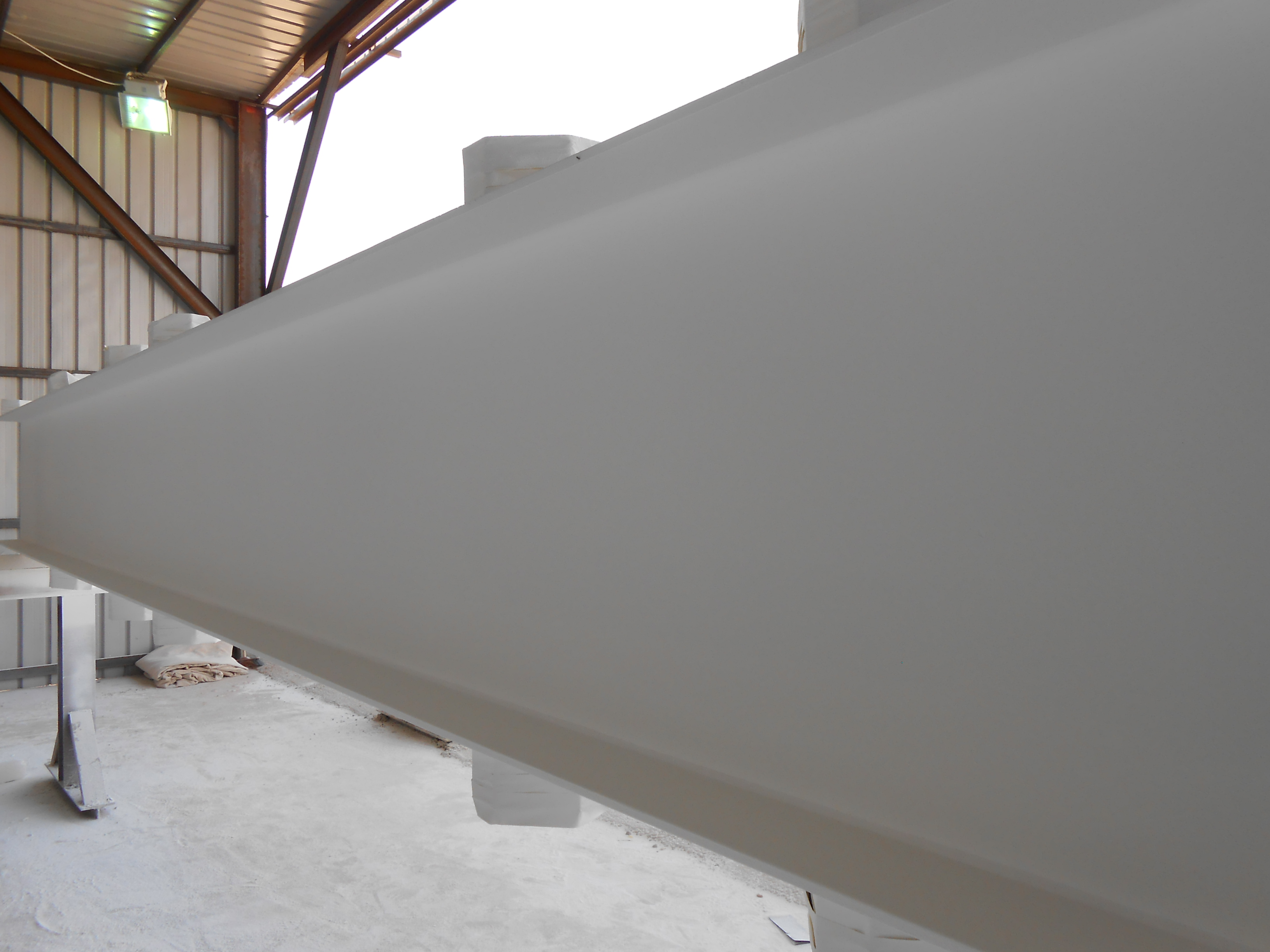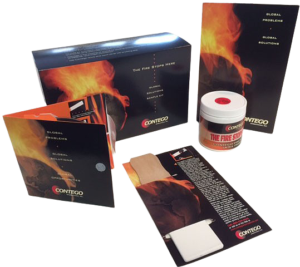SIMPLE APPLICATION
Contego Intumescent RFB (Reactive Fire Barrier) provides easy surface preparation, easy application instructions, and is water-based for easy cleanup.
There are ZERO toxins, VOCs, carcinogens and mutagens as per our ASTM D4017 “Results of Volatile Organic Compound Content (VOC) Testing of Contego (HS) Intumescent”, as well as having a no-foul-smell formulae. Because of this, Contego does not require specially contractors, specialized equipment, or specialized protective gear.
Contego can be shop applied, allowing direct-from-manufacturer solutions using standard painting equipment.
SUPER THIN FINISH
Contego offers super thin film technology, where beauty and form meet functionality and safety. It is aesthetically pleasing while meeting LEED standards.
Contego is top coat-able for perfect aesthetics. Top coatings increase fire resistance by about 25%. This is based on our ASTM E-119 UL-263, ULC-S101 “Standard Methods of Fire Tests of Building Construction & Materials”, which evaluated the effect of a top coat of acrylic enamel using a highly flammable Rust-O-Leum alkyd based paint.
Contego lets you bring out the best in any design no matter what substrate needs protecting. According to our extensive test results from leading independent fire testing laboratories such as UL, Intertek, and Warrington, we can protect the following substrates with super thin coatings:

*Please note dry film thicknesses may vary depending on the substrate, the member size, and or assembly requirements by your local AHJ.
SUPERIOR PERFORMANCE
With unmatched latency, Contego is perhaps the only intumescent manufacturer using a dual redundant QC analysis of our entire production. We use UL, Materials Analytical Services and MAGI to critically evaluate our product on an ongoing basis using spectroflouroscopic analysis. Note how each graph over the past 20 years is essentially identical.*UPLOAD Link or graph here add chemical signature percentage. With these results, unopened product would have no expiration date.
Our revolutionary HS (high solids) formula adheres tightly to all substrates at a 630 PSI Adhesion rate, based on our ASTM D4541 “Pull-Off Strength of Coatings Using Portable Adhesion Testers”. This adhesion rate is twice that of our closest IFRM competitor and up-to 15x of SFRM “Spray On Fire Resistant Materials”. If your fireproofing material does not stick, or falls off, it can not protect the substrate in the event of a fire!
Our ASTM D-2240 test “Durometer hardness: Shore D” results were based on the average of five readings-Shore D value 66. Our ASTM D4060 “Standard Test Method for Abrasion resistance of Organic Coatings by the Taber Abraser” coating was applied at a wet mil thickness of 30 mils. Duplicate panels were tested, and the average weight loss was determined to be 295.4 mg.
Technical specs are great, but Contego also sets a NEW STANDARD in fire resistance, with a 0x0 Flame Spread & Smoke Production on structural steel, based on our UL-723/ULc-S102 ASTM-E84 “Fire Resistance Test”, as well as a 5×40 Flame Spread & Smoke Production on Dimensional Lumber or Wood products. This exceeds the results of other intumescent fireproofing materials results for steel. Now that is impressive.
Contego products are vetted, approved, and are listed as BASIS OF DESIGN on Global platforms MasterSpec and BSD Speclink architectural software networks.
With all this proven performance, Contego International Inc. will back it up with our 10 year warranty, which is unheard of in the industry today!
SAVE TIME SAVE MONEY
Time is money, and you will save both with Contego.
With Contego’s intumescent technology, you can save both time and money on your project in the design phase, purchasing phase, and project phase. Let’s take a look at all three in a comparative value to both IFRM’s and SFRM’s in the market today.
Design Phase
Leading the way in the industry, our 2 HR intumescent fire rated D603 Floor-Ceiling UL-263, CAN/ULC-S10 Composite Steel Deck Design allows architects and structural engineers the flexibility to reduce the concrete slab by 40% per floor assembly and still meet building codes and fire ratings to achieve 1, 1 ½ , and 2 hour fire resistance throughout North America.
In the past, intumescent fireproofing was not an option on steel decking until our High Solids formula was tested, approved, and certified by UL Northbrook, IL to be applied to a floor ceiling assembly, thereby eliminating the need to install mesh flooring or drop ceilings to catch old technology such as SFRM debris and fibers prone to fall off the substrate ceiling.
Purchasing Phase
Our product is super thin. In the past, intumescent paint has been expensive, and most of our competitors still are pricey due to the fact 3-4 times more of their product needs to be used to meet the same fire ratings as Contego. For example, on 2 hour fire rating see this chart:

You can use the data above and see the HUGE cost savings on both material purchased and labor factors used to apply the intumescent paint needed to build up the dry film thickness x multiple coats-increasing your cost per square foot.
We recommend you take one of your past, present, or future projects and find out how much you would save yourself with our Project Planner-Steel Calculator. Request your copy today.
Project Phase
One of the biggest challenges on a project is scheduling interchanging components, materials and sub-contractors from one day to the next and keeping the build on-time.
With Contego you can be rest assured there will be no schedule or sequencing issues. Traditional spray on fire resistant materials would require a general contractor to shut down or close off sections of the project so that HAZ-MAT team of sprayers could spray the highly toxic fireproofing materials. Contego does not require shut-downs or section close-offs. Our product contains ZERO VOCs, has no foul odor, and applicators can work alongside other subcontractors to keep your project moving forward.
So you can see, whether you are a designer, project planner, or lead contractor, the value of trying Contego on your next project from start to finish. The bigger the project, the bigger the savings for everyone.
FEATURED PROJECTS
When you specify Contego you are in good company. To learn about our global footprint and find out why businesses from hospitals, universities, concert venues and stadiums across Canada, to hotels, airports, airplanes and raceways in the United States, railways in Saudi Arabia, ferris wheels in Dubai, and manufacturing & shopping malls in Asia trust Contego to protect their properties. Here are some of our featured projects across the Globe
Asia:
Honda Automotive, Shanghai New Ideal Company
Middle East:
Saudi Arabia Railway, The Dubai Eye
Europe
British Antarctic Halley Research Station
United States
Hyatt Hotels, Chicago Midway Airport, Stanford University, Michigan International Speedway, Bigelow Airspace, Malstrom Air Force Base, Walgreens
Canada
William Osler Brampton Civic Hospital, MUN Memorial University Core Sciences, Budweiser Stage, Eglinton Crosstown LRT, Investors Field, Scotia Centre, Tim Hortons Event Centre, Shoppers Drug Mart, Canada Post, Bombardier BRP
•To schedule a conference call or ZOOM meeting please email us at info@contegointernational.com to book an appointment today!•






 Standard application of Contego intumescent coating results in a beautifully smooth Level 3 architectural finish. For interior projects, Contego can be top-coated with any quality acrylic enamel for surface protection and decorative purposes.The example to the right shows Contego intumescent fire protection compared to SFRM materials on the market. What finish would you prefer?
Standard application of Contego intumescent coating results in a beautifully smooth Level 3 architectural finish. For interior projects, Contego can be top-coated with any quality acrylic enamel for surface protection and decorative purposes.The example to the right shows Contego intumescent fire protection compared to SFRM materials on the market. What finish would you prefer? Projects treated with Contego will meet fire code with a super thin film. Steel actually looks like steel and you’ll need less product, thereby reducing the overall cost. It also means the weight on your steel doesn’t blow your structural loading plan out of the water. With just 100 Mil DFT (2.54 mm or 0.10 inches) you can protect Composite Steel Decking for 2HR based on our UL263 CAN/ULc S101 Floor/Ceiling Design D603.
Projects treated with Contego will meet fire code with a super thin film. Steel actually looks like steel and you’ll need less product, thereby reducing the overall cost. It also means the weight on your steel doesn’t blow your structural loading plan out of the water. With just 100 Mil DFT (2.54 mm or 0.10 inches) you can protect Composite Steel Decking for 2HR based on our UL263 CAN/ULc S101 Floor/Ceiling Design D603.  Now here’s a big plus, as we’ve hinted throughout this list, you get ALL of the advantages we’ve shared with you delivered at the lowest cost per square foot of any other intumescent. Many projects run over budget and Contego is your ace in the hole when it comes to value engineering. The bigger the project, the more you save!!!
Now here’s a big plus, as we’ve hinted throughout this list, you get ALL of the advantages we’ve shared with you delivered at the lowest cost per square foot of any other intumescent. Many projects run over budget and Contego is your ace in the hole when it comes to value engineering. The bigger the project, the more you save!!! Contego is pioneering the (IFRM) intumescent fireproofing industry, pushing the standards higher with each test result. Testing the 1st 2HR UL D603 Composite Steel Deck Floor/Ceiling Design back in 2018, now testing the 1st Full Scale Dimensional Lumber Floor/Ceiling (13ft x 19ft OSB, I-Joist Assembly)
Contego is pioneering the (IFRM) intumescent fireproofing industry, pushing the standards higher with each test result. Testing the 1st 2HR UL D603 Composite Steel Deck Floor/Ceiling Design back in 2018, now testing the 1st Full Scale Dimensional Lumber Floor/Ceiling (13ft x 19ft OSB, I-Joist Assembly) The test specimen was tested load bearing with a 40 lb/ft2 superimposed load applied in four increments of 25% before the fire exposure, allowing for stabilization of deflection after each increment.
The test specimen was tested load bearing with a 40 lb/ft2 superimposed load applied in four increments of 25% before the fire exposure, allowing for stabilization of deflection after each increment.






 Are you concerned about the future of projects where cementitious or cellulosic fireproofing has been applied? You should be.
Are you concerned about the future of projects where cementitious or cellulosic fireproofing has been applied? You should be.
 Once you breathe it in, it going to be in your body forever and potentially the source for a wide range of medical problems like COPD and mesothelioma. These and other diseases can cause respiratory impairment or even fatalities.
Once you breathe it in, it going to be in your body forever and potentially the source for a wide range of medical problems like COPD and mesothelioma. These and other diseases can cause respiratory impairment or even fatalities.







